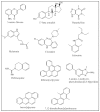Review of Ligand Specificity Factors for CYP1A Subfamily Enzymes from Molecular Modeling Studies Reported to-Date
- PMID: 28698457
- PMCID: PMC6152251
- DOI: 10.3390/molecules22071143
Review of Ligand Specificity Factors for CYP1A Subfamily Enzymes from Molecular Modeling Studies Reported to-Date
Abstract
The cytochrome P450 (CYP) family 1A enzymes, CYP1A1 and CYP1A2, are two of the most important enzymes implicated in the metabolism of endogenous and exogenous compounds through oxidation. These enzymes are also known to metabolize environmental procarcinogens into carcinogenic species, leading to the advent of several types of cancer. The development of selective inhibitors for these P450 enzymes, mitigating procarcinogenic oxidative effects, has been the focus of many studies in recent years. CYP1A1 is mainly found in extrahepatic tissues while CYP1A2 is the major CYP enzyme in human liver. Many molecules have been found to be metabolized by both of these enzymes, with varying rates and/or positions of oxidation. A complete understanding of the factors that govern the specificity and potency for the two CYP 1A enzymes is critical to the development of effective inhibitors. Computational molecular modeling tools have been used by several research groups to decipher the specificity and potency factors of the CYP1A1 and CYP1A2 substrates. In this review, we perform a thorough analysis of the computational studies that are ligand-based and protein-ligand complex-based to catalog the various factors that govern the specificity/potency toward these two enzymes.
Keywords: P450 1A1; P450 1A2; active site; cytochrome; docking; dynamics; molecular modeling; quantitative structure activity studies (QSAR).
Conflict of interest statement
The authors declare no conflict of interest.
Figures











Similar articles
-
Characterization of differences in substrate specificity among CYP1A1, CYP1A2 and CYP1B1: an integrated approach employing molecular docking and molecular dynamics simulations.J Mol Recognit. 2016 Aug;29(8):370-90. doi: 10.1002/jmr.2537. Epub 2016 Feb 25. J Mol Recognit. 2016. PMID: 26916064
-
Ortho-Methylarylamines as Time-Dependent Inhibitors of Cytochrome P450 1A1 Enzyme.Drug Metab Lett. 2017;10(4):270-277. doi: 10.2174/1872312810666161220155226. Drug Metab Lett. 2017. PMID: 28000546 Free PMC article.
-
Molecular modelling of CYP1 family enzymes CYP1A1, CYP1A2, CYP1A6 and CYP1B1 based on sequence homology with CYP102.Toxicology. 1999 Nov 29;139(1-2):53-79. doi: 10.1016/s0300-483x(99)00098-0. Toxicology. 1999. PMID: 10614688
-
Cytochrome P450 family 1 inhibitors and structure-activity relationships.Molecules. 2013 Nov 25;18(12):14470-95. doi: 10.3390/molecules181214470. Molecules. 2013. PMID: 24287985 Free PMC article. Review.
-
Synthetic and natural compounds that interact with human cytochrome P450 1A2 and implications in drug development.Curr Med Chem. 2009;16(31):4066-218. doi: 10.2174/092986709789378198. Curr Med Chem. 2009. PMID: 19754423 Review.
Cited by
-
A Computational Inter-Species Study on Safrole Phase I Metabolism-Dependent Bioactivation: A Mechanistic Insight into the Study of Possible Differences among Species.Toxins (Basel). 2023 Jan 18;15(2):94. doi: 10.3390/toxins15020094. Toxins (Basel). 2023. PMID: 36828409 Free PMC article.
-
Association Between CYP1A1 Polymorphisms and Esophageal Cancer Susceptibility: A Case-control Study.In Vivo. 2023 Mar-Apr;37(2):868-878. doi: 10.21873/invivo.13155. In Vivo. 2023. PMID: 36881057 Free PMC article.
-
In Silico Design and SAR Study of Dibenzyl Trisulfide Analogues for Improved CYP1A1 Inhibition.ChemistryOpen. 2022 May;11(5):e202200016. doi: 10.1002/open.202200016. ChemistryOpen. 2022. PMID: 35610057 Free PMC article.
-
Coumarin-Based Profluorescent and Fluorescent Substrates for Determining Xenobiotic-Metabolizing Enzyme Activities In Vitro.Int J Mol Sci. 2020 Jul 1;21(13):4708. doi: 10.3390/ijms21134708. Int J Mol Sci. 2020. PMID: 32630278 Free PMC article. Review.
-
Adaptable Small Ligand of CYP1 Enzymes for Use in Understanding the Structural Features Determining Isoform Selectivity.ACS Med Chem Lett. 2018 Oct 29;9(12):1247-1252. doi: 10.1021/acsmedchemlett.8b00409. eCollection 2018 Dec 13. ACS Med Chem Lett. 2018. PMID: 30613334 Free PMC article.
References
-
- Shimada T., Yamazaki H., Mimura M., Inui Y., Guengerich F.P. Interindividual variations in human liver cytochrome P-450 enzymes involved in the oxidation of drugs, carcinogens and toxic chemicals: Studies with liver microsomes of 30 Japanese and 30 Caucasians. J. Pharmacol. Exp. Ther. 1994;270:414–423. - PubMed
Publication types
MeSH terms
Substances
Grants and funding
LinkOut - more resources
Full Text Sources
Other Literature Sources
Molecular Biology Databases

